Telangana SCERT 8th Class Social Guide Telangana Lesson 11A National Movement: The Early Phase 1885-1919 Textbook Questions and Answers.
TS 8th Class Social Lesson 11A Questions and Answers – National Movement: The Early Phase 1885-1919
Improve Your Learning
Question 1.
Correct the false statements : (Conceptiuil understanding)
a. In the early phase of Indian National Congress it included only people from Bombay.
b. Indian industrialists began to establish companies in different parts of India.
c. People in India expected that India would become democratic after the First World War. (Reading the text (‘given), understanding and interpretation)
Answer:
Statement (a) is false. The correct statement is that during the early phase of Indian National Congress, it included people largely from Bombay, Madras, and Calcutta.
Question 2.
Write an imaginary dialogue between the extremist and moderate activists of Indian National Congress in the context of their a) main demands; and b) mode of action. (Conceptual understanding)
Answer:
Imaginary dialogue between extremist and moderate activists of Indian National Congress in the context of their main demands and mode of mobilization :
Extremists: “According to us, the Swadeshi movement should be extended further to the rest of India. We should demand for a full-fledged freedom. It is our birthright. No one has the right to treat us as slaves. Let us give out the slogan – Swaraj is my birth right and I shall have it.”
Moderate activists: “Yes whatever you are saying is true. But we should not rush into things and make it a mess. For the time being, let us not extend the movement any further.”
Extremists: “We cannot sit here in peace anymore It’s high time we planned something against the British rule. Let us not go by the old rules of submitting petitions to the government which is similar to mendicancy. We have come up with a new strategy.”
Moderate activists: “What is it?”
Extremists: “Let us protest against the British rule for freedom ourselves. We should mobilize the masses against the British rule and force them to give up.”
Moderate activists: “We don’t think it is right. Let us continue on a more gradual pace of movement, Moreover, we don’t think that the masses are ready for a full-scale movement for freedom and self-rule.”
![]()
Question 3.
After reading this chapter Mariamma thinks that the early phase of national movement was largely participated by educated Indians. And many of their ideas were of western origin. Will you agree with her? Give reasons. Reading the text (given), understanding and interpretation)
Answer:
Yes, I agree with her. The reasons are as follows:
- During 1866 to 1885, various leaders like Surendranath Banerjee, Justice M.G. Ranade, Badruddin Tyabji K.C. Telang, and G. Subramaniam organized associations in Calcutta, Pune. Bombay and Madras to discuss the problems faced by Indians in those provinces.
- These associations had nationalistic zeal and tried to unite intellectuaLs. Though many of these associations functioned in specific parts of the country, their goals were stated as the goals of all the people of India, not those of any one religion, community, or class.
- They worked with the idea that the people should be sovereign – a modern consciousness and a key feature of nationalism.
- They believed that the Indian people should be empowered to take decisions regarding their affairs.
- They realized the importance of discussing the policies of the government and organizing campaigns to change them.
Question 4.
Why was it important to understand the economic impact of British rule in India? (Conceptual understanding)
Answer:
- Leaders like Naoroji, R.C. Dutt, and Ranade studied the economic impact of the British Rule and concluded that the British were draining India of her wealth through taxes and other means and leaving her poorer and poorer.
- They drew the attention to the problem of poverty and famines and blamed it on the British policies of excessive land revenue, export of grains etc.
- The early leaders were convinced of the need for national industrial development to end poverty in India.
- The British rule was standing in the way of development as they not only were draining the wealth of India to England but also enabling cheap selling of British goods in India and restraining Indian crafts and industries.
- Hence it was important to understand the economic impact of British rule in India.
Question 5.
What do you understand by Swadeshi? What were the major areas of its impact? (Conceptual understanding)
Answer:
The word Swadeshi derives from Sanskrit and is a conjunction of two Sanskrit words. Swa means “self’ or “own” and Desh means “country”. SoSwadesh would be “own country”, and Swadeshi, the adjectival form, would mean “of one’s own country.” The Swadeshi movement focused on issues of boycotting English cloth and salt as a revenge to the partitioning of Bengal in 1905.
There was also a call for boycott of all government institutions like schools, colleges, courts etc. It also gave tremendous impetus to Indian industry and demand for indigenous goods. Swadeshi salt, sugar, matches, and other products were manufactured on a large scale.
Question 6.
How did different parts of the country and people respond to division of Bengal? (Conceptual understanding)
Answer:
- Students, women, and a large section of the urban and rural population of Bengal and other parts of India became actively involved in politics for the first time.
- The Nationalists considered the partition of Bengal as a political act by the government to divide the Bengali people and also to weaken the National movement.
- There were massive protests, petitions, and campaigns even by the ordinary people of Bengal.
- Boycotts and public burning of foreign products became common in remote corners of Bengal and in many important towns and cities throughout the country.
- Swadeshi schools, colleges, and courts were set up in order to refuse to cooperate with the government to run it and undermine its position in this way.
Question 7.
Locate the following in India map:
a. Calcutta Kolkata)
b. Madras (Chennai)
c. Bomuay (Mumbai)
d. Lucknow
Answer:
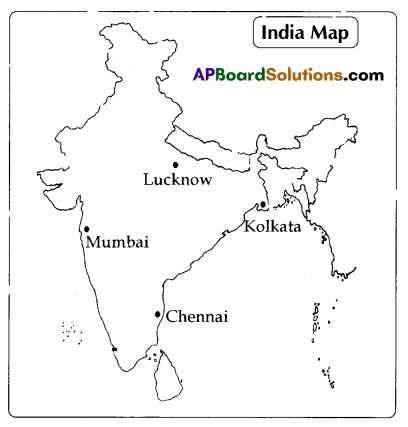
Question 8.
Locate the following in the World map:
a. Britain
b. France
c. Russia
d. Germany
Answer:
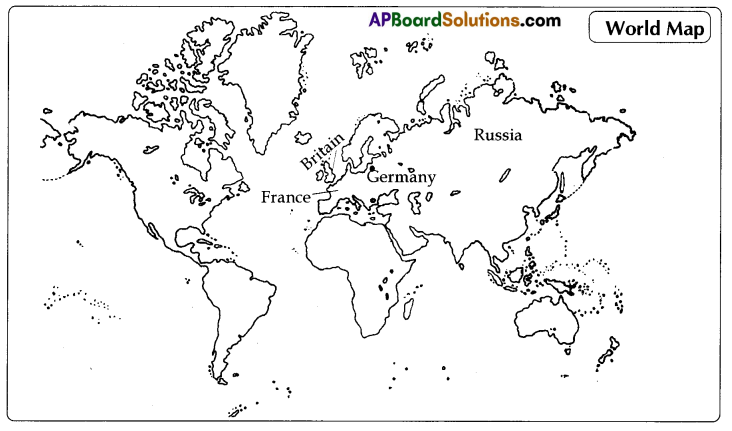
![]()
Question 9.
A few leaders like Gandhi, Tilak, Subhash Chandra Bose, Bhagat Singh sacrificed their lives for the sake of our nation. What would have happened, if the did not do sot (Appreciation and Sensitivity)
Answer:
It great leaders like Gandhi. Tilak, Subhash Chandra Bose, Bhagat Singh did not sacrifice their lives for the sake of our nation, then we would not have achieved freedom from the British rule and would have continued to be their slaves till date.
Question 10.
Are there any movements that hase taken place in your region recently? Why?
Answer:
Recently anti-corruption movement spread like tire in our region. Everyone inspired by’ Anna Hazare began protesting against corrupted government officials. People are vexed up with the corruption down from peon to a top rank officer. There is good awareness among public that corruption is cancer to the society.
Project
Question 1.
Collect photos of national leaders who participated in freedom struggle and prepare an album. Make a report on it and present in the class.
Answer:
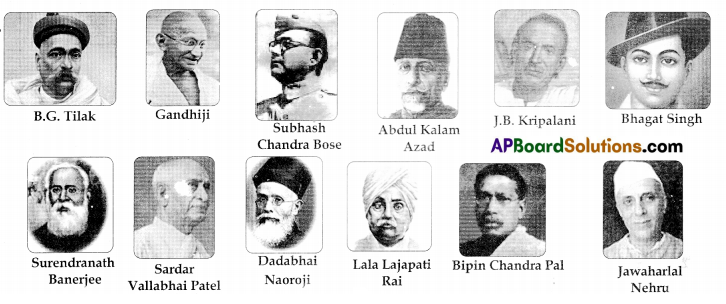
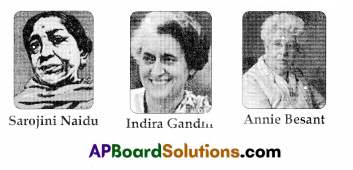
Many great leaders sacrificed their lives for our motherland. I collected photos of some them. Gandhiji preached non-violence. He made it a weapon to drive away the British. Tilak understood the lack of unity was the main cause for the suffering of India s. He started Ganesh Chaturthi that arouse national feelings in all.
Subhash Chandra Bose and Bhagat Singh thought only civil war can bring independence. In the attempt, Subhash Chandra Bose formed Indian National Army. Patel served a lot by merging all local provinces in Indian Union. All these leaders both men and women loved country, served without any selfish motto. It is their sacrifices that bore fruits and we are tasting today.
Intext Questions
Textbook Page No. 120
Question 1.
Do you know of any association in your village or town which discusses the problems faced by all people (not just of one caste or community)? What do they discuss? What suggestions do they have for solving those problems? Discuss some examples in the class. (Information skills)
Answer:
- Diwancheruvu is a Grama Panchayat headquarters of Diwancheruvu, Sreerampuram, and Raghunadha puram Villages in East Godavari District of Andhra Pradesh State in India.
- Grama Panchavats are the administrative institutions at village level. Panchayat means a committee or an assembly of FIVE persons to look after the welfare and the integrated development of the public (villagers) of one or more habitations.
- Panchayat is composed of wise and respected men (Elders) chosen (Elected) anti accepted by the village community. These assemblies settle disputes between individuals and villages.
- They invite both the parties of the dispute, listen carefully to their grievances and provide justice in favour of the innocent.
Textbook Page No. 122
Question 2.
Why did the early nationalists believe that the British were responsible for the poverty and famines in India? (Conceptual understanding)
Answer:
Leaders like Naoroji, R.C. Dutt and Ranade studied the economic impact of the British Rule and concluded that the British were draining India of her wealth through taxes and other means and leaving her poorer and poorer. They drew the attention to the problem of poverty and famines and blamed it on the British policies of excessive land revenue, export of grains etc.
Question 3.
Why do you think did not the early nationalists want to re-establish the ule of the old kings cf lndia Would it not have been better than he ritish rule? (Conceptual understanding)
Answer:
‘The soldiers, ordinary peasants, artisans and landlords and even princes joined the struggle against the British rule. While the movement was opposed to the British, it did n0t want to restore the rule of the old kings and queens either. The nationalists were in favour of democratic rule but not for autocrat or kings or hereditary rule.
The nationalists pretty well Knew the dictatorial tendencies of the old kings and their greed for enjoying benefits of powder but how they didn’t care Common public.
The nationalists also knew the narrow-mindedness of kings which destabilised the country through foreign invasions. No, it would not have been better than the British Rule but an equivalent to it.
![]()
Text Book Pge No. 124
Question 4.
Imagine yourself as a student participating in a burning of foreign cloth. describe what all would have happened on that day and your feelings at that time.
Answer:
The British Rule was becoming unbearable day by day for the people. I saw that women, students like me, and a large section of the urban and rural population of Bengal and other parts of India were actively participating in politics for the first time.
The major trigger for the movement was the proposal for partitioning of Bengal into East and Vest Bengal in 1903 b Curzon. I was enraged by this act and went to the streets along with the ordinary people of Bengal to protest about it. We decided that the English cloth and salt should be boycotted.
There was tremendous mass response for this decision. We all gathered at the center of the city and burnt all the foreign clothes. Women also refused to wear foreign bangles and destroyed foreign utensils I was very glad while putting the foreign clothes on fire.
The British officials who saw this were very angered. But we were not afraid of them and continued our protest.
Question 5.
If authorities do not agree to the just requests of people, what do you think should the people do? (Reflection an contemporary issues and questioning)
Answer:
If authorities do not agree to the just requests of the people. then people should sign petitions and start campaigns regarding the issue. The people should protest peacefully without causing any harm to anybody. People should offer their support peacefully to the protest.
Question 6.
Find out more about the First World War and its impact on the lives of ordinary people. (Conceptual understanding)
Answer:
The First World War was fought across Europe, European colonies, and the surrounding seas between August 1st, 1914, and November 11th 19th. Contemporaries called it “The Great War because it was literally greater than any waged before: Over 59 million troops were mobilized, over S million died and over 29 million were injured in a struggle which sharply altered the political, economic, social, and cultural nature at Europe.
‘Ripples’ were felt across the world as nations from every (nonpolar) continent entered the war.
Impact on the lives of ordinary people:
In India. the war brought great suffering for the common people as the British tried to raise funds and resource% for the war by raising taxes, exporting food and other necessities to the army.
Question 7.
During that period there were massive movements of people who opposed the war and asked their governments to cease fighting with other countries and restore peace. Do you think it was correct? (Appreciation and Sensitivity)
Answer:
Yes, it was absolutely correct. Wars bring unprecedented human suffering, inequality among nations, and destruction. Hence, they should be avoided by protesting against them.
A. “With the start of the Swadeshi movement around 1903, the Indian national movement took a major leap forward. Women, students and a large section of the urban and rural population of Bengal and other parts of India became action rely involve red in politics for the first time.”
Read the above paragraph “with the start ………………. first time” and answer the following question. Explain the contribution of Swadeshi Movement?
Answer:
- The Swadeshi Movement opposed British rule and encouraged the idea of self-help, swadeshi enterprise, national education, and use of Indian languages.
- The radicals advocated mass mobilization and boycotted the British institutions and goods to fight for swara.
B. ‘In 1866, Dadahbai Naoroji organized the” East India Association” in London to discuss the Indian question. During 1866 to 1885. various leaders like Surendranath Banerjee, ¡ustice M.G. Ranade, Badruddin Tyabji, K.C. Telang and G. Subrarnan yam organized associations in Calcutta, Pune, Bombay, and Madras to discuss the problems faced by Indians in those provinces :
Read the above paragraph ‘In 1866, Dadabhai Naoroji ……………. those provinces” and answer the following question.
What was important about these associations mentioned in the passage?
Answer:
1. These associations functioned in specific parts of the country.
2. Their goals were common goals of all the people of India, not those of any one region, community or class.
Information Skills
Question 1.
Study the table and answer the questions that follow.
Answer:
| Topic | Definition |
| 1. Swadeshi Movement | The word Swadeshi derives from Sanskrit and is a conjunction of two Sanskrit words. Swa means “self” or “own” and Desh means country, so Swadeshi would be “own country”, and Swadeshi, the adjectival form, would mean “of one’s own country.” The Swadeshi movement focused on issues of boycotting English cloth and salt as a revenge to the partitioning of Bengal in 1905. |
| 2. First World War (1914-1919) | The First world war broke out in 1914 with Britain, France, Russia on one side and Germany and its allies on the other side. It lasted for nearly five years till Germany was finally defeated. |
1. What does the term Swadeshi mean?
Answer:
The word Swadeshi derives from Sanskrit and is a conjunction of two Sanskrit words. Swa means “self” or “own” and Desh means country, so Swadesh would be “own country”, and Swadeshi, the adjectival form, would mean “of one’s own country.”
2. When did the First World War commence?
Answer:
In the year 1914.
3. Which country was defeated in the First World War?
Answer:
Germany
4. For how many years did the First World War last?
Answer:
Nearly five years.
![]()
Question 2.
Krishna Patrika was started in Machilipatna,n in 1902. Mutnuri Krishna Rao was One of the founders of the paper and from 1902 was associated will, il as its Sub-editor. in 1907 he became its editor and continued lo serve the journal, till he died in 1945. The
Krishna Patrika carried on publicity for all the phases of ladies struggle for freedom, like. the Vandematarmm, movement, the Home Rule movement, the Non-Cooperation the Civil-disobedience Movement and the Quit India Movement. The Krishna Patrika influenced not only the urban educated elite but also the rural misses. Both the magazine and its editor courted the wrath of the British rulers several times.
1. When did Krishna Patrika established?
Answer:
1902.
2. Who was founder of Krishna Patrika?
Answer:
Mutriuri Krishna Rau.
3. Name the movements mentioned in the above passage.
Answer:
Vandemataram movement, Home ru le movement, Non-Cooperation movement, and Civil-disobedience movement.
4. Where did Krishna Patrika established?
Answer:
Machilipatnam.
Appreciation and Sensitivity
Question 1.
Write about the role of Krishna Patrika in freedom movement of Machilipatnam.
Answer:
- Krishna Patrika was started in Machilipatnam in 1902, Mutnuri Krishna Rao was one of the founders of the paper and from 1902 was associated with it as its Sub-editor.
- In 1907 he became its editor and continued to serve the ournal till he tiled in 1945.
- The Krishna Patrika supported all the phases of India’s struggle for freedom like the Vandemataram movement, the Home Rule movement, the Non – Cooperation movement, the Civil Disobedience Movement, and the Quit India Movement.
- The Krishna Patrika influenced not only the urban-educated elite but also the rural masses.
- Both the magazine and its editor courted the wrath of the British rulers several times.
Question 2.
Write few lines about the following people.

Answer:
1. Surendranath Banerjee: Sir Surendranath Banerjee (10 November 1848 – 6 August 1925) was one of the earliest Indian political leaders during the British Raj. He founded the Indian National Association, one of the earliest Indian political organizations, and later became a senior leader of the Indian National Congress. He was also known by the Sobriquet, Rashtraguru (the teacher of the nation).
2. G.K. Ghokale: Gopala Krishna Gokhale (9 May 1866 – 19 February 1915) was one of the founding social and political leaders during the Indian Independence Movement against [ht’ British Empire in India. Gokhale was a senior leader of the Indian National Congress and founder of the “Servants of India Society’. Through the Society as well as the Congress and other legislative bodies he served in, Gokhalt’ promoted not only primary independence from the British Empire hut also social reform. To achieve his goals, Gokhale followed two overarching principles: non-violence and reform within existing government institutions.
3. Dadabhai Naoroji Dadabhai Naoroji (4 September 1825-30 June 1 17), known as the Grand Old Man of India’, was a Parsi intellectual, educator, cotton trader, and an early Indian political and social leader. He was a Member of Parliament (MP) in the United Kingdoms’ House of Commons between 1892 and 1895, and the first Asian to be a British MP.
Mapping Skills
A) Map Pointing:
Map the following places in the India, map:
1. Madhya Pradesh
2. West Bengal
3. Mumbai
4. Madras
5. Kolkata
6. Hyderabad
7. Puna
8. Bihar
Answer:
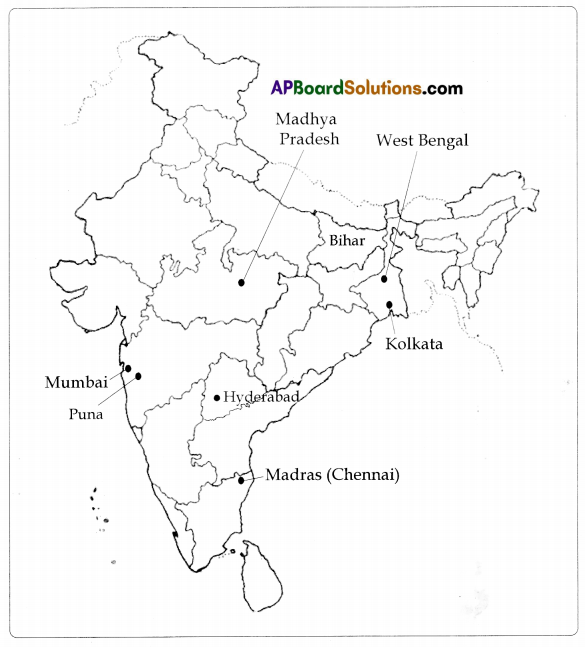
One Mark Questions
Question 1.
When was East India Association established in London?
Answer:
1866.
Question 2.
Who was the first woman graduate from Calcutta?
Answer:
Kadambari Ganguli.
Question 3.
Who were the leaders of Home rule Movement?
Answer:
Annie Besant and Hala Gangadhara Tilak.
Question 4.
Who was responsible for partition of Bengal?
Answer:
Lord Curzon.
![]()
Question 5.
Name some of the moderate leaders.
Answer:
Gopala Krishna Gokhale, Surendranath Banerjee.
Question 6.
Where was the first session of Indian National Congress held?
Answer:
Bombay.
Question 7.
Who was the owner of Bengal Chemical Works?
Answer:
P.C. Roy.
Question 8.
Who was the founder of Krishna Patrika?
Answer:
Sree Mutnuri Krishna Rao,
Question 9.
What was the major policy of moderates?
Answer:
Pray, petition, and protest.
Question 10.
What was the period of First world war?
Answer:
1914 – 1919
Objective Type Questions
Question 1.
The difference between the Moderates and Extremists grew and eventually led to a split of the Congress in ……………………. into two. ( )
A) 1909
B) 1907
C) 1915
D) 1921
Answer:
B) 1907
Question 2.
The Swadeshi movement focused on issues of boycotting English cloth and salt as a revenge to the partitioning of Bengal in. ………………….. . ( )
A) 1905
B) 1907
C) 1919
D) 1885
Answer:
A) 1905
Question 3.
The song Vandemataram was written by ( )
A) Surendranath Banerjee
B) G.K. Ghokale
C) Dadabhai Naoroji
D) Bankimchandra Chatterjee
Answer:
D) Bankimchandra Chatterjee
Question 4.
The first session of the Indian National Congress held at …………. In 1885.
A) Lucknow
B) Bombay
C) Chennai
D) Delhi
Answer:
B) Bombay
![]()
Question 5.
Kadambari Ganguli was the first woman gradute From ( )
A) Tirupathi
B) Bombay
C) Calcutta
D) Delhi
Answer:
C) Calcutta
Question 6.
Find the correct one ( )
A) Moderate period – 1919-1930
B) Extremist period – 1885-1905
C) Gandhi Era – 1905 – 1919
D) Lucknow pact. – 1916
Answer:
A) Moderate period – 1885-1905
B) Extremist period – 1905 – 1919
C) Gandhi Era – 1916
D) Lucknow pact – 1905 – 1919
Question 7.
……………………… was known as grand old man of India ( )
A) Lala Lajpat Rai
B) Hal Gangadhar Tilak
C) Bipin Chandra Pal
D) Dadabhai Naoroji
Answer:
D) Dadabhai Naoroji
Question 8.
The leader that belongs to extremists phase ( )
A) WC. Banerjee
B) Surendranath Banerjee
C) Pheroze Shah Mehta
D) Bipin Chandra Pal
Answer:
C) Pheroze Shah Mehta
Question 9.
Find out True statement ( )
A) Moderate phase – 1885-1905
B) Extremist phase – 1905 -1920
C) Gandhi Era – 1920 – 1947
D) All of above
Answer:
D) All of above
Question 10.
Founder of Indian National Congress ( )
A) A.O. Hume
B) W.C. Banerjee
C) Jawaharlal Nehru
D) Sarojini Naidu
Answer:
A) A.O. Hume
Question 11.
……………….. was the first woman graduate from Calcutta ( )
A) Aruna Chatterji
B) Neha Banvai
C) Kadambari Ganguli
D) Sarojini Naidu
Answer:
C) Kadambari Ganguli
Question 12.
Partition of Bengal took place in …………………… year. ( )
A) 1905
B) 1906
C) 1907
D) 1908
Answer:
A) 1905
Question 13.
…………………….. was responsible for partition of Bengal ( )
A) Lord Canning
B) Lord Mount Batten
C) General Dyer
D) Lord Curzon
Answer:
D) Lord Curzon
Question 14.
‘Swaraj is my birthright and I shall have it’ is the famous slogan given by ……………. . ( )
A) Bala Gangadhar Tilak
B) Bipin Chandra Pal
C) Lala Lajpat Rai
D) Subhash Chandra Bose
Answer:
A) Bala Gangadhar Tilak
Question 15.
‘Krishna Patrika’ was started by …………………. . ( )
A) Rayaprolu Subba Rao
B) Tatineni Subba Rao
C) Tanguturi Prakasam Pantulu
D) Mutnuri Krishna Rao
Answer:
D) Mutnuri Krishna Rao
![]()
Question 16.
Of the following which is NOT true. ( )
A) First Indian National Congress was held in 1885.
B) W.G. Banerjee presided over the first Indian National Congress.
C) Its main objective was to take up social reforms.
D) A.O. Hume played an important role in establishing the Congress
Answer:
A) First Indian National Congress was held in 1885.
Question 17.
Who adopted the policy of ‘pray, petition and protest’ in freedom struggle? ( )
A) The Moderates
B) The Extremists
C) Followers of Gandhi
D) Social reformers
Answer:
A) The Moderates
Question 18.
The importance of Lucknow Pact 1916. ( )
A) Krishna Patrika was started,
B) The two factions – Moderates and Extremists of Congress Party united.
C) First World War ended.
D) The partition of Bengal.
Answer:
B) The two factions – Moderates and Extremists of Congress Party united.
Question 19.
Tilak joined Rands with Anni Besant to launch ( )
A) Vandemataram movement
B) Quit India movement
C) Home Rule movement
D) Swadeshi movement
Answer:
C) Home Rule movement
Question 20.
The Extremists did not succeed in their idea of ‘Swaraj’. Yet, the appreciable thing in them ( )
A) They were imprisoned.
B) They earned properties.
C) The made Britishers leave the country.
D) They could keep alive the spirit of nationalism.
Answer:
C) The made Britishers leave the country.